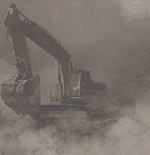 |
Road Density |  |
 |
Road Density |  |
In regions inhabited by both wolves and humans, the later are often the overwhelming factor in the former's mortality. Highways, freeways, streets, and dirt roads, in one way or another, are often man's accomplice in this matter. In Canada, Alaska, and northern Minnesota there exists a distinct, inverse correlation between road and wolf density; in other words, more roads mean fewer wolves.
Roads are hazardous to wolves for two reasons. First, roads open up the back country to human intrusion and make it easier for hunters
and poachers to kill, maim, or otherwise disturb wolves. Furthermore, logging, homesteading, and
other human activities potentially destructive to wolves and their habitat often follow the bulldozer and steam roller into the forests. Second, roads are paths by which three-quarter ton projectiles--deadly to wolves and other wildlife--careen through the countryside taking out unsuspecting and/or confused animals. In some areas, wildlife biologists estimate that wolf-automobile 'encounters' account for nearly 30% of wolf mortality.
The US Fish and Wildlife Service has determined that the road density threshold for long-term wolf survival in any given area is approximately one mile of road per mile squared of habitat. Therefore, in considering prospective release sites, the Fish and Wildlife Service recommends that only those sites with road densities below this threshold be considered for wolf release.
Using GIS, I calculated the road density of the Big Bend Wolf Recovery Area...
The steps involved in creating this map are as follows::
- First, I downloaded the following files from TNRIS: the 1:24,000 TXDOT county files for Brewster and Presidio counties, and the Sierra del Carmen park boundary file.
- From the TXDOT coverages I selected the boundaries for Big Bend National Park, Big Bend Ranch State Park, and the Black Gap Wildlife Management Area. I then put these arcs into a separate coverage and built it to create polygon topology. I named this coverage parks3.
- Next, I appended the parks3 coverage with the arcs from the Sierra del Carmen coverage, built it again, and renamed it parks4.
- I then created a buffer coverage from parks4 (...you guessed it- parksbuff). When creating the coverage I set the buffer distance to 10 miles.
- I then went back to the TXDOT coverages and selected all of the road and street features. I put these arcs into a separate coverage, named it roads, and built it with the line option to preserve arc topology.
- Next, I clipped the roads file with parksbuff to create roadsbuff.
- I then started an ARC/View session and added parks4, parksbuff, and roadsbuff to the view window. I opened the tables for both the parksbuff and roadsbuff coverages, selected the appropriate columns, and clicked on the statistics button to calculate the area of parksbuff and the cumulative road length for roadsbuff. Because the map units for both coverages are in meters, I had to convert these numbers to miles.
The total area of parksbuff is 7,191 square miles. The total length of paved and unpaved roads within parksbuff is 579 miles. The road density is thus .08 miles of road per square mile of habitat, well below the USFWS-recommended threshold.
Problems with the Analysis
While working on the roads segment of this project a number of questions came to mind, including:
Is there some way that paved roads can be weighted more heavily than dirt roads to reflect their greater danger? Also, shouldn't we consider the amount of traffic on each road and somehow include this in the database and calculations? Obviously, if I-10 ran through the middle of the park, it would create a greater hazard for wolves than the roads currently there..
Also, how does one define a road? I know of a number of jeep trails which were not included in the TXDOT files yet are clearly accessible by automobile.
Additionally, there is one significant problem with my analysis. Though the Mexican portion of the Big Bend Wolf Recovery Area is sparsely settled, there are a few people living and working in the area. Likewise, there are a few roads. These roads will have to be included in the dataset to improve the accuracy of my calculation.
